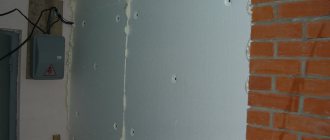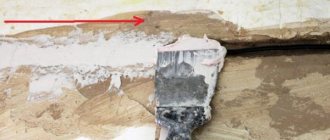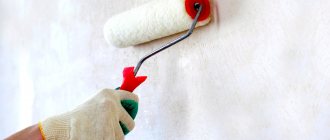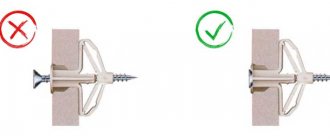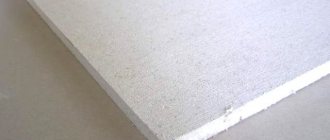About the material and its features
The material was invented in America back in the 19th century, and has not fundamentally changed since then. Its name contains all the information about the structure: the compressed gypsum mixture is bounded on both sides between sheets of construction paper (cardboard). Initially, gypsum boards were used for the installation of partitions and ceilings, for cladding; later, more complex design structures began to be made from it.
Modern industry, in addition to standard, produces moisture- and fire-resistant plasterboard, as well as material with increased sound insulation (acoustic) or with increased strength (gypsum fiber).
The gypsum core is a compressed natural mineral (the gypsum fiber variety is additionally reinforced with cellulose), thanks to which gypsum plasterboard has a certain elasticity, but is also susceptible to deformation. Because of this, for example, it is not stored vertically, leaning against the wall - the sheet may bend.
Structure of moisture-resistant drywall Source ispovednik.ru
Also, when using power tools, pressed plaster crumbles with pleasure and forms clouds of fine dust, which is not recommended to be inhaled. This is considered a good reason to abandon power tools in favor of manual processing in many processes.
The standard sheet has dimensions of 2.5x1.2 m, thickness 12.5 mm; Other sizes are also available. You have to resort to cutting quite often, at least in order to adjust the material to size or cut a technological hole (for example, for sockets). The operation is not particularly difficult, but it requires the correct choice of tool and knowledge of some subtleties when performing different types of cutting.
Tools: choosing the right ones
A variety of tools are suitable for working with gypsum boards, which are available in the arsenal of most owners. But the answer to the question of what is better for cutting drywall can be different, since each tool is selected to solve a specific task.
These tools are suitable for working with drywall Source jurnalprodom.ru
Construction (assembly) knife
The tool does an excellent job of cutting drywall; what is important is that the yield of gypsum dust will be minimal. The use of the knife has the following features:
- The tool's capabilities are limited. With its help, it is almost impossible to accurately cut a complex figured (curved) line, but a straight cut is perfect.
- Straight cut technology. It is enough to apply markings and cut through the top layer of cardboard; then the sheet is simply broken along the groove.
- Pro Tip: Use a metal (or wood) ruler to guide the knife along the markings. The cut will be more even, and the blade will not move to the side.
- The mounting knife can be replaced with a carefully sharpened kitchen analogue.
Using a mounting knife: cutting under a ruler Source demandstudios.com
Wood hacksaw
The hacksaw has its own characteristics:
- With its help, shaped and rectangular (closed) holes are cut equally well.
- Do not use a hacksaw to cut drywall along the long side. The edge turns out to be uneven, which is bad, for example, for joining adjacent parts.
- How neat the cut will be depends on the blade of the hacksaw; the thinner it is, the more accurate and smooth the result will be.
- A hacksaw is a slow tool; If you want to cut a sheet of drywall into pieces, use a utility knife.
See also: Catalog of companies that specialize in finishing materials and related work
Jigsaw
The advantage of a power tool is its high speed of operation, the ability to save time and effort, the disadvantage is the formation of a large amount of dust. A jigsaw is suitable for cutting plasterboard according to shaped patterns; For cutting, choose a metal file with a small (about 1 mm) tooth.
Sawing a closed hole with a jigsaw Source obustroeno.club
Additionally
You will also need the following devices:
- Electric drill. Supplemented with core bits and large-diameter feather drills, it will help you cut out sockets for sockets and switches, as well as holes for utilities.
- Planer (it is better to choose a special tool for drywall). It is needed for grinding the edges of the gypsum board edges, where a flat joint is provided, or for creating chamfers (with subsequent putty).
- Needle roller. It will help you make notches on the HA sheet to make it easier to change the shape later. The tool is indispensable when installing complex structures (for example, multi-tiered ceilings).
- Marking tool. To accurately mark the lines, you cannot do without a simple pencil (or marker). It will be complemented by a ruler (metal, 1 m), a construction square, and a tape measure.
- An auxiliary tool for obtaining long, even cuts. The easiest way is to use a construction rule with a smooth working edge.
Accurate marking is an important component of a quality result Source aviarydecor.com
Offers from manufacturers
Here are visual examples of some jigsaws that will help you cope with cutting drywall of any complexity:
- Model BOSCH PST 700 E:
| Parameter | Description |
| Homeland of the brand | Germany |
| Manufacturer country | Hungary |
| Power | 0.5 kW |
| Stroke length | 2 cm |
| Cord length | 240 cm |
| Color | Green |
| Weight | 1700 g |
| Price | 4230 rubles |
Prices are valid for spring 2022.
Model BOSCH PST 700 E is a bright representative of German quality
- Model Makita 4329:
| Parameter | Description |
| Homeland of the brand | Japan |
| Manufacturer country | Romania |
| Power | 0.45 kW |
| Stroke length | 1.8 cm |
| Cord length | 200 cm |
| Color | Blue |
| Weight | 1900 g |
| Price | 3630 rubles |
The Makita 4329 model is equipped with an anti-vibration system that simplifies the operation of the jigsaw
- Model Interskol MP-100/700E:
| Parameter | Description |
| Homeland of the brand | Russia |
| Manufacturer country | People's Republic of China |
| Power | 0.705 kW |
| Stroke length | 2.6 cm |
| Cord length | 250 cm |
| Color | Gray-black |
| Weight | 2900 g |
| Price | 3900 rubles |
The Interskol MP-100/700E model is a representative of the domestic brand, practically not inferior to foreign electric jigsaws in terms of performance indicators
Subtleties of proper cutting
In order to get a high-quality cut of a plasterboard sheet, you should adhere to the following conditions:
- Pressed plaster will crumble and become dusty even with the most careful handling. To protect your eyesight and respiratory organs, the simplest means are enough: a respirator and glasses.
- The flexibility of gypsum boards makes choosing a place of work important. Before sawing drywall, it is important to ensure a level and stable work surface.
- Most varieties of gypsum plasterboard do not like moisture. The wet leaf swells; You can dry it, but you cannot use it. A dry room is required for work.
- If there is no ruler or rule for the required length, a long cut can be done in parts.
- It is more practical to make a cut from the back side of the sheet (the one that will be hidden inside the structure) - you don’t have to waste time aligning the edge, all errors will remain reliably masked.
Using the Multi-Tool Source ebayimg.com
Cutting technique for beginners
The first question that a beginner has is: how to properly cut drywall to size. The mistake of inexperienced users is that, not understanding the properties of plasterboard, they often choose the wrong tool and spend a lot of time and effort on cutting.
Of course, you can use a hacksaw to cut the drywall into pieces, but the work will take longer, leave a lot of dirt, and the resulting nicks will make it difficult to join adjacent edges. A justified choice would be to use a construction knife in the following sequence of actions:
- Markings are made using a ruler and pencil.
- Apply a ruler to the marking points and cut along the line with a knife; You must guide the blade confidently, without jerking.
- The sheet with the markings is lifted vertically onto its edge, they stand on the uncut side of the sheet and make a couple of knee strikes. The sheet will break exactly according to the markings.
Separating a fragment of drywall Source aviarydecor.com
- Using a knife, cut the sheet from the reverse side (where the cardboard is still intact).
- The edge turns out to be uneven, so it is sanded with a plane. A straight edge will help the sheets fit snugly against each other.
Communication box
The last but not least popular idea is to use leftover drywall in the interior. Using this useful and practical material, you can create a spectacular shaft that completely hides utility wiring or sewer pipes in the bathroom and kitchen. Such a box is very easy to manufacture, and when decorating it, you can take into account the overall concept of the interior.
We have provided 12 solutions that are found everywhere. All methods have been tested and confirmed in practice, so you can safely use them during renovations in your apartment. The main thing is, don’t be afraid to show your imagination and ingenuity, and you will get an unusually impressive interior with plasterboard structures.
Cutting techniques
Various problems arise in the construction process, and convenient techniques have been developed to solve them. Gypsum is highly fragile and in order not to spoil the material, you should adhere to the technology. This is especially important if it is necessary to make some kind of curved structure, to bend the gypsum board. Cutting techniques will be different in the following cases:
- On the wall. You can cut the drywall after it has been fixed to the wall (for example, if you need to decorate a corner of a wall or a window opening). To do this, the sheet is securely fixed on the supporting surface, and the part protruding beyond its edge is cut off with a knife. To ensure a smooth cutting line, markings are first applied. This method allows you to avoid mistakes, since the cutting line is drawn directly according to the shape of the base.
Cutting a round hole in gypsum board Source tenona.ru
- Hole for socket (lamp). It is cut out both before and after fixing the gypsum board to the base; The first option is more suitable for beginners. The most important thing is not to miss the location, so it is useful to make notes from the inside of the sheet. To cut a hole, use a hacksaw or drill (screwdriver) with a round attachment (a drywall bit).
- Cut along the uneven line. If you need to cut a radius (curved) shape, use a jigsaw; and choose a narrow blade with fine teeth. The work progresses quickly, but dust is generated, so glasses and a respirator must be used in conjunction with power tools.
- GCR bending. Sometimes design tasks require the creation of a semicircular arch. There is a dry and wet bending method, but you should always choose a special material for curved surfaces. Such sheets have a reduced thickness, and the production technology allows them to be bent without special tools. Sometimes, to simplify the task, they resort to a plywood template or clamps.
Bending gypsum board along the workpiece Source dekoriko.ru
Cutting out curly elements
When you need to cut out a piece of drywall to create a window or doorway, do the following.
- They draw boundaries. Typically a square or rectangle.
- One side of the drywall sheet is sawn through with a hacksaw from edge to corner.
- The second - with a knife, using the previously described standard method.
If the cutout is U-shaped, then use a hacksaw to saw off two opposite sides. The third is cut with a knife. After that, the unnecessary piece is broken and the cardboard is trimmed from the back side.
There are times when you need to make a hole, stepping back from the edge of the sheet. Several methods are applicable.
- Draw contours of the required dimensions on both sides of the sheet. Using a knife, cut as deep as possible on both sides. The corners are cut especially carefully. Lightly tap to knock out the middle.
- Drill several holes around the perimeter of the contour. Use a hacksaw to cut out the unnecessary part of the sheet.
- Carefully, so that cracks do not appear across the entire surface of the drywall, punch a hole in the middle. Using a knife or hacksaw, cut out the required size in parts.
USEFUL INFORMATION: Drywall slopes: do-it-yourself installation
Edge processing
In many cases, sections require additional processing. The need arises, for example, if plasterboard walls are intended for wallpaper, and good joining of adjacent sheets is important. It is performed in the following sequence:
- The edge formed after the cut is processed with a roughing plane to achieve a smooth surface without kinks.
- If the cut edges form a seam, they are prepared for puttying: they are chamfered with an edge plane at an angle of 22.5° (1/3 of the sheet thickness). If the seam will be reinforced with tape, the angle is adjusted to 45° (2/3 of the sheet thickness).
- A layer of putty is applied to the joint using a spatula and screwdriver. The mass is leveled with a vertical movement, the excess is removed.
- It is considered a mistake to use a mounting knife instead of an edge plane, as well as the formation of edges after fixing the plasterboard on the base; As a result, cracks may form along the joint line.
A chamfer is made if a smooth joining is required Source aviarydecor.com
Rectangular holes in drywall
A hacksaw is used to cut holes. Mark a rectangle on the sheet with a pencil. A hole is made in the corner of the rectangle with a drill so that a hacksaw can fit into it. The saw is held perpendicular to the plane of the sheet.
If the rectangular hole is located at the edge of the sheet, then the horizontal cut is made with a saw, and the vertical cut with a knife. Then the sheet in this place is simply broken off.
Briefly about the main thing
Before you begin installing plasterboard, you need to familiarize yourself with the methods of processing it. Cutting drywall is not difficult, but ignorance of the technology will lead to damage (and, therefore, excess consumption) of raw materials.
Like any universal building material, drywall undergoes various transformations: it is bent, straight and curved cuts are made, and holes are prepared for sockets and pipes. Different tools are used for different types of work, but markings are made first. If the accuracy of the joint is important for finishing, the edges of the sheets are cleaned; To ensure the angle is accurate, use an edge plane and make a chamfer, and seal the joint with putty.
Ratings 0
What is made from gypsum board remnants?
It is already common knowledge that drywall is a universal material that can be used in various variations of interior renovation and decoration. There are several ways to use gypsum boards in home decoration:
- furniture;
- decorative items;
- cladding material.
plasterboard boxes
, niches, fireplaces, gypsum plasterboard shelves, plasterboard arches.
Now it is very fashionable to use facing stone made of gypsum or brick, which can be created from ordinary plasterboard.
